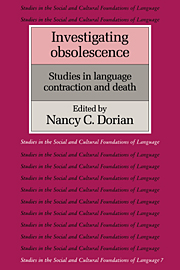Book contents
- Frontmatter
- Contents
- List of maps
- List of contributors
- Preface
- Map
- Dedication
- Introduction
- I Focus on context
- 1 On language death in eastern Africa
- 2 The disappearance of the Ugong in Thailand
- 3 Scottish and Irish Gaelic: The giant's bed-fellows
- 4 The rise and fall of an immigrant language: Norwegian in America
- 5 Breton vs. French: Language and the opposition of political, economic, social, and cultural values
- 6 “Persistence” or “tip” in Egyptian Nubian
- 7 Sociolinguistic creativity: Cape Breton Gaelic's linguistic “tip”
- 8 Skewed performance and full performance in language obsolescence: The case of an Albanian variety
- 9 On the social meaning of linguistic variability in language death situations: Variation in Newfoundland French
- 10 The social functions of relativization in obsolescent and non-obsolescent languages
- II Focus on structure
- III Invited commentaries
- Bibliography
- Index of languages
- General index
9 - On the social meaning of linguistic variability in language death situations: Variation in Newfoundland French
Published online by Cambridge University Press: 08 January 2010
- Frontmatter
- Contents
- List of maps
- List of contributors
- Preface
- Map
- Dedication
- Introduction
- I Focus on context
- 1 On language death in eastern Africa
- 2 The disappearance of the Ugong in Thailand
- 3 Scottish and Irish Gaelic: The giant's bed-fellows
- 4 The rise and fall of an immigrant language: Norwegian in America
- 5 Breton vs. French: Language and the opposition of political, economic, social, and cultural values
- 6 “Persistence” or “tip” in Egyptian Nubian
- 7 Sociolinguistic creativity: Cape Breton Gaelic's linguistic “tip”
- 8 Skewed performance and full performance in language obsolescence: The case of an Albanian variety
- 9 On the social meaning of linguistic variability in language death situations: Variation in Newfoundland French
- 10 The social functions of relativization in obsolescent and non-obsolescent languages
- II Focus on structure
- III Invited commentaries
- Bibliography
- Index of languages
- General index
Summary
Introduction
In the light of more than two decades of research in the Labovian framework, conducted mainly in urban speech communities, there exists a widespread belief that linguistic variability is most likely to appear when there is strong socio-economic stratification, or even that it only appears under these circumstances. This is the impression left, intentionally or not, by statements such as the following by D. Sankoff and Laberge (1978:239):
Though it is well known that the internal differentiation of spoken language is related to social class, the scientific study of this relationship poses a number of very different problems.
and by Labov (1966:111):
Variation in linguistic behavior does not in itself exert a powerful influence on social development, nor does it affect drastically the life chances of the individual; on the contrary, the shape of linguistic behavior changes rapidly as the speaker's social position changes.
Quantification of linguistic data according to linguistic environment and according to the speaker's social class is basic to the methodology of this branch of sociolinguistics. It is also an underlying assumption that variables involved in a linguistic change necessarily carry sociosymbolic meaning.
In the language death literature, it has been shown that variation may arise in languages undergoing attrition as a result of a language death process whereby simplified variants gradually replace more complex variants, especially in the speech of semi-speakers (see e.g. Dorian 1978c). Schmidt (1985a) also gives evidence for the creation of new, complex variants in dying Dyirbal.
- Type
- Chapter
- Information
- Investigating ObsolescenceStudies in Language Contraction and Death, pp. 139 - 148Publisher: Cambridge University PressPrint publication year: 1989
- 14
- Cited by



